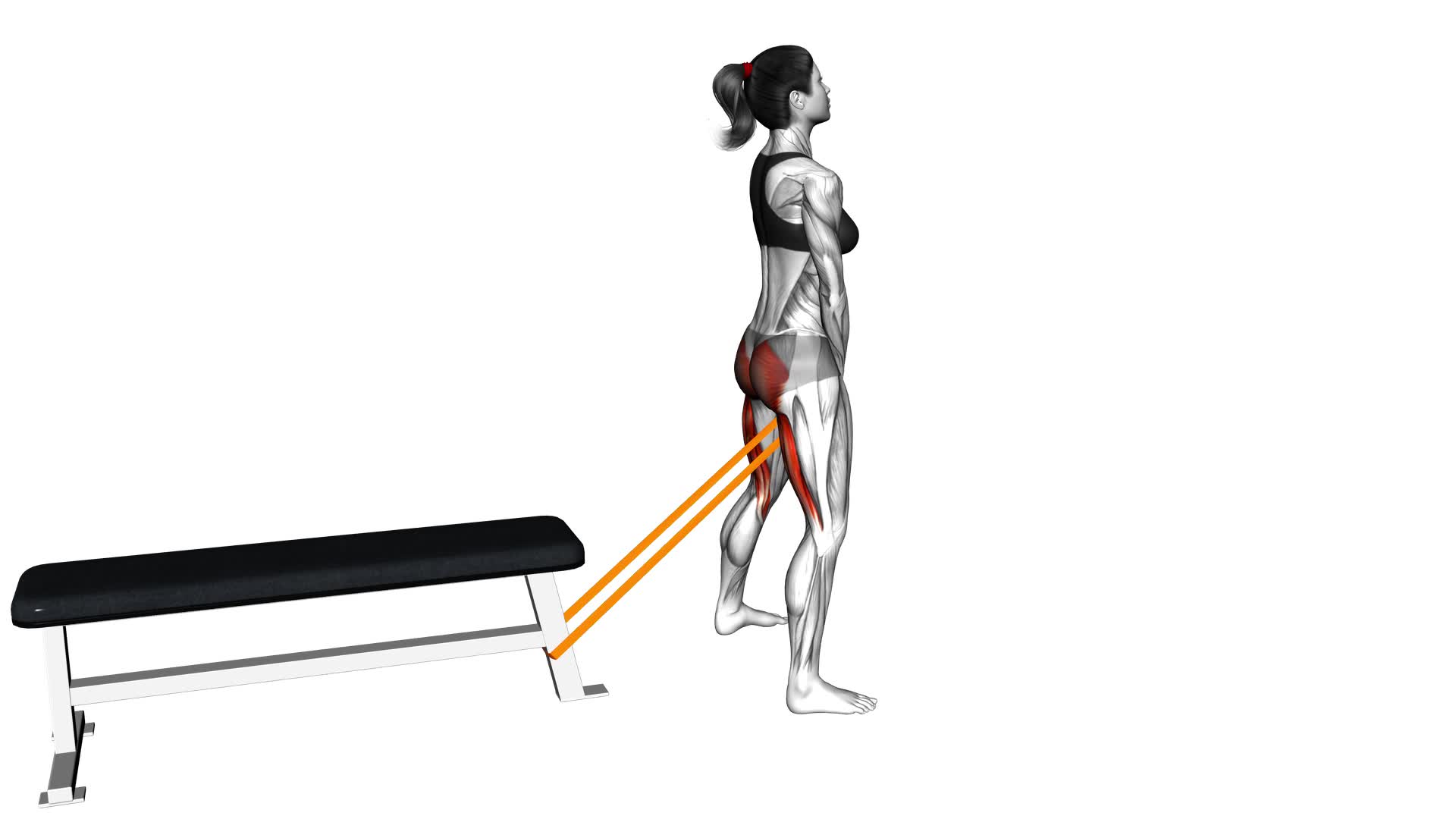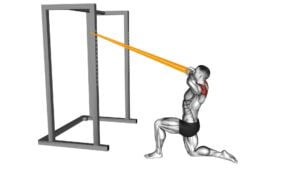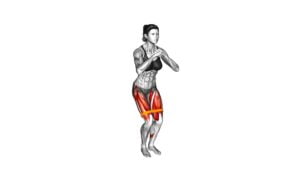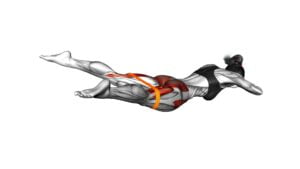Resistance Band Pull Through (female) – Video Exercise Guide & Tips

Looking to strengthen your glutes and improve your overall lower body strength? The resistance band pull through is a fantastic exercise for targeting those muscles.
Watch This Exercise Video
In this video exercise guide, we'll show you proper form and technique, as well as variations and modifications to suit your fitness level.
Maximize your results with these expert tips.
Get ready to feel the burn and take your workouts to the next level with the resistance band pull through.
Let's get started!
Key Takeaways
- Resistance band pull through targets multiple muscle groups simultaneously, including the glutes, hamstrings, and core.
- Using a resistance band increases the challenge and intensity of the exercise, leading to greater muscle activation and improved strength gains.
- Resistance band pull through provides constant tension for more effective muscle contraction compared to traditional weightlifting exercises.
- It is important to maintain proper form and technique, such as engaging the core, avoiding swinging the body, and keeping the spine neutral, to protect the lower back and maximize results.
Benefits of Resistance Band Pull Through
One benefit of the resistance band pull through is that it allows you to target multiple muscle groups simultaneously. This exercise engages your glutes, hamstrings, and core, making it an efficient and effective way to strengthen and tone these areas. By using a resistance band, you add extra resistance to your movements, increasing the challenge and intensity of the exercise. This can lead to greater muscle activation and improved strength gains.
Resistance band exercises, like the pull through, offer several advantages over traditional weightlifting exercises. They're portable and easy to carry, allowing you to perform your workout anywhere, whether at home, in the gym, or while traveling. Additionally, resistance bands provide constant tension throughout the movement, resulting in a more effective muscle contraction and greater muscle fiber recruitment.
If you're looking for alternative exercises for the resistance band pull through, there are a few options you can try. One alternative is the glute bridge, which targets the glutes and hamstrings. Another option is the kneeling hip thrust, which also focuses on the glutes and core. Both exercises can be modified to incorporate a resistance band for added challenge. Remember to start with a lighter resistance band and gradually increase the resistance as you become stronger and more comfortable with the exercises.
Equipment Needed for Resistance Band Pull Through
To perform the Resistance Band Pull Through exercise, you'll need a resistance band. This versatile piece of equipment is essential for resistance band exercises and can help you strengthen and tone your muscles.
Here are four key things to consider when choosing a resistance band for the Pull Through exercise:
- Resistance level: Resistance bands come in different levels of resistance, typically indicated by colors. Choose a band that provides enough resistance to challenge your muscles without causing strain.
- Length: Make sure the resistance band is long enough to allow you to perform the exercise with proper form. It should be able to stretch from the anchor point behind you to your feet in front of you.
- Durability: Look for a resistance band made from high-quality materials that can withstand repeated use. It should be able to stretch without snapping or losing elasticity.
- Handles: Some resistance bands come with handles attached, which can provide a more comfortable grip during the exercise. However, if you prefer, you can also use a looped resistance band without handles.
If you don't have access to a resistance band, there are alternatives you can use for the Pull Through exercise. You can try using a cable machine, a TRX suspension trainer, or even a towel or rope for resistance. Just make sure to anchor the alternative equipment securely before performing the exercise.
Proper Form and Technique for Resistance Band Pull Through
To perform the Resistance Band Pull Through exercise with proper form and technique, focus on maintaining a strong core and engaging your glutes throughout the movement. This exercise primarily targets the glutes and hamstrings, while also engaging the core and lower back muscles.
One common mistake to avoid is using too much momentum. Instead, make sure to control the movement and avoid swinging your body. This will ensure that the targeted muscles are properly engaged and that you get the most out of the exercise.
Another mistake to watch out for is rounding your back. Keep your spine neutral and your chest up throughout the movement. This will help protect your lower back and maintain proper form.
To perform the exercise, start by attaching the resistance band to a sturdy anchor point behind you. Stand facing away from the anchor point, with your feet shoulder-width apart and a slight bend in your knees. Grab the resistance band with both hands and hold it at chest height.
Keeping your core engaged, hinge at the hips and push your hips back while maintaining a slight bend in your knees. Continue to push your hips back until you feel a stretch in your glutes and hamstrings.
To complete the movement, engage your glutes and hamstrings to pull your hips forward and return to the starting position. Repeat for the desired number of repetitions. Remember to maintain proper form and engage your glutes throughout the entire movement for maximum effectiveness.
Variations and Modifications for Resistance Band Pull Through
Try incorporating different resistance bands of varying strengths to challenge yourself and customize the intensity of the Resistance Band Pull Through exercise. Here are some variations and modifications you can try to take your workout to the next level:
- Single-leg Pull Through: Perform the exercise with one leg lifted off the ground. This variation increases the demand on your glutes and hamstrings, as well as your core stability.
- Banded Pull Through with Squat: Add a squat to the movement by bending your knees and lowering into a squat position as you pull the resistance band through your legs. This modification adds an extra challenge to your lower body muscles.
- Banded Pull Through with Row: Incorporate an upper body exercise by adding a row to the movement. After pulling the band through your legs, bring your elbows back, squeezing your shoulder blades together. This modification targets your back muscles and improves your posture.
- Banded Pull Through with Bicep Curl: Combine the pull through with a bicep curl to engage your arm muscles. After pulling the band through your legs, bend your elbows and curl the resistance band towards your shoulders. This modification adds an extra burn to your biceps.
Avoid these common mistakes when performing the Resistance Band Pull Through exercise: allowing your lower back to round, using too much momentum, and not maintaining proper form throughout the movement. Remember to engage your core, keep a neutral spine, and control the movement using your glutes and hamstrings.
Tips for Maximizing Results With Resistance Band Pull Through
To maximize your results with the Resistance Band Pull Through, focus on proper technique and form. These tips will help you get the most out of your resistance band exercises.
Firstly, make sure you have the right resistance band for your fitness level. Using a band that's too easy or too challenging can limit your progress. Choose a band that provides enough resistance to challenge your muscles without compromising your form.
Next, pay attention to your posture and alignment throughout the exercise. Keep your back straight, shoulders back, and core engaged. This will help you maintain stability and prevent any unnecessary strain on your body.
When performing the Resistance Band Pull Through, make sure to engage your glutes and hamstrings. Focus on squeezing these muscles as you pull the band through your legs. This will help you target these muscle groups effectively and maximize your results.
Additionally, control the movement throughout the exercise. Avoid using momentum to pull the band through. Instead, focus on a slow and controlled motion, emphasizing the contraction of your glutes and hamstrings.
Lastly, incorporate the Resistance Band Pull Through into a well-rounded workout routine. Combine it with other resistance band exercises and strength training exercises to target different muscle groups and optimize your overall results.
Frequently Asked Questions
How Many Calories Does the Resistance Band Pull Through Burn?
The resistance band pull through is an effective exercise for burning calories. By incorporating resistance bands into your workout routine, you can intensify the benefits of this exercise.
To perform the resistance band pull through with proper form, start by standing with your feet shoulder-width apart and holding the band with both hands. Engage your core and hinge at the hips, pulling the band through your legs.
This movement engages multiple muscle groups and can help you burn calories efficiently.
Can Resistance Band Pull Through Exercises Help With Lower Back Pain?
Resistance band pull through exercises can be effective for strengthening your glutes and hamstrings. They can also help with lower back pain by improving your core stability and posture.
To perform this exercise correctly, start by standing with your feet shoulder-width apart and the band looped around your ankles. Hinge at your hips, keeping your back straight, and push your hips forward to pull the band through your legs.
Focus on engaging your glutes and hamstrings throughout the movement for maximum effectiveness.
Is the Resistance Band Pull Through Suitable for Beginners?
Yes, the resistance band pull through is suitable for beginners. This exercise can be modified to fit your fitness level. It's a great way to strengthen your core muscles and improve overall stability.
Can the Resistance Band Pull Through Be Done Without a Fitness Mat?
Yes, you can do the resistance band pull through without a fitness mat.
The exercise primarily targets your glutes and hamstrings.
To modify it, you can vary the resistance band pull through variations. For example, you can try using a heavier or lighter resistance band to increase or decrease the difficulty level.
Remember to maintain proper form and engage your core throughout the movement.
How Long Should I Rest Between Sets During a Resistance Band Pull Through Workout?
When doing a resistance band pull through workout, it's important to consider your rest duration between sets. The length of your rest will depend on your exercise intensity and how much you need to recover.
Typically, it's recommended to rest for about 30 seconds to 1 minute between sets. This allows your muscles to recover and maintain the right level of intensity for each set.
Remember to listen to your body and adjust the rest duration as needed.
Conclusion
Incorporating resistance band pull through exercises into your routine can provide numerous benefits. These include improved core strength, increased hip mobility, and enhanced overall body stability. By using the proper equipment and maintaining proper form, you can maximize your results and avoid potential injuries.
Don't forget to explore variations and modifications to challenge yourself and keep your workouts exciting. Start incorporating resistance band pull through exercises into your fitness routine today for a stronger and more balanced body.

Author
Years ago, the spark of my life’s passion ignited in my mind the moment I stepped into the local gym for the first time. The inaugural bead of perspiration, the initial endeavor, the very first surge of endorphins, and a sense of pride that washed over me post-workout marked the beginning of my deep-seated interest in strength sports, fitness, and sports nutrition. This very curiosity blossomed rapidly into a profound fascination, propelling me to earn a Master’s degree in Physical Education from the Academy of Physical Education in Krakow, followed by a Sports Manager diploma from the Jagiellonian University. My journey of growth led me to gain more specialized qualifications, such as being a certified personal trainer with a focus on sports dietetics, a lifeguard, and an instructor for wellness and corrective gymnastics. Theoretical knowledge paired seamlessly with practical experience, reinforcing my belief that the transformation of individuals under my guidance was also a reflection of my personal growth. This belief holds true even today. Each day, I strive to push the boundaries and explore new realms. These realms gently elevate me to greater heights. The unique combination of passion for my field and the continuous quest for growth fuels my drive to break new ground.







